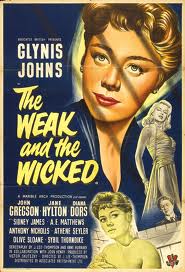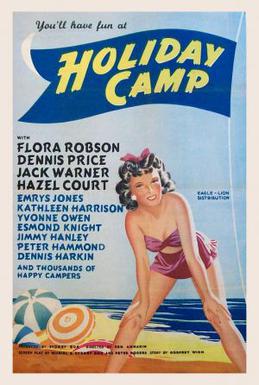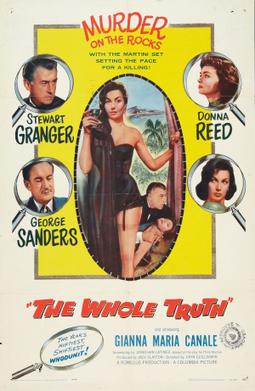
Diana Dors was an English actress and singer.

John Gregson, born as Harold Thomas Gregson, was an English actor of stage, television and film, with 40 credited film roles. He was best known for his crime drama and comedy roles.

John Lee Thompson was a British film director, active in London and Hollywood, best known for award-winning films such as Woman in a Dressing Gown, Ice Cold in Alex and The Guns of Navarone along with popular and cult pictures like Cape Fear, Conquest of the Planet of the Apes, Battle for the Planet of the Apes and The White Buffalo.

Lady Godiva Rides Again is a 1951 British comedy film starring Pauline Stroud, George Cole and Bernadette O'Farrell, with British stars in supporting roles or making cameo appearances. It concerns a small-town English girl who wins a local beauty contest by appearing as Lady Godiva, then decides to pursue a higher profile in a national beauty pageant and as an actress.

A Kid For Two Farthings is a 1955 British comedy-drama film directed by Carol Reed. The screenplay was adapted by Wolf Mankowitz from his 1953 novel of the same name. The title is a reference to the traditional Passover song, "Chad Gadya", which begins "One little goat which my father bought for two zuzim". At the end of the film, Mr. Kandinsky softly sings fragments of an English translation of the song.

Joan Benham was an English actress best known for her portrayal of Lady Prudence Fairfax in the ITV period drama series Upstairs, Downstairs. She was born in London and was the first cousin of Hollywood actress Olive Sturgess.

The Weak and the Wicked is a 1954 British drama film directed by J. Lee Thompson based on the autobiographical novel Who Lie in Gaol by his wife, Joan Henry, starring Glynis Johns and Diana Dors.

Girls in Prison is a 1956 American sexploitation women in prison drama film about a young woman who is convicted of being an accomplice to a bank robbery and is sent to an all-female prison. The film was directed by Edward L. Cahn, and stars Richard Denning, Joan Taylor, and Mae Marsh. American International Pictures released the film as a double feature with Hot Rod Girl.

Holiday Camp is a 1947 British comedy drama film directed by Ken Annakin, starring Flora Robson, Jack Warner, Dennis Price, and Hazel Court, and also features Kathleen Harrison and Jimmy Hanley. It is set at one of the then-popular holiday camps. It resonated with post-war audiences and was very successful. It was the first film to feature the Huggett family, who went on to star in "The Huggetts" film series.

Nor the Moon by Night is a 1958 British drama film directed by Ken Annakin and starring Belinda Lee. It was based on the novel by Joy Packer and partly filmed in the Kruger National Park, South Africa. The title is a quote from the Old Testament passage ; "The sun shall not smite thee by day, nor the moon by night."

An Alligator Named Daisy is a 1955 British comedy film directed by J. Lee Thompson and starring Donald Sinden, Jeannie Carson, James Robertson Justice, Diana Dors, Roland Culver and Stanley Holloway.

The Whole Truth is a 1958 British-American thriller film directed by John Guillermin and starring Stewart Granger, George Sanders, Donna Reed, Gianna Maria Canale and Peter Dyneley. It was based on the 1955 play of the same title by Philip Mackie.

Eyewitness is a 1956 British thriller film directed by Muriel Box and starring Donald Sinden, Muriel Pavlow, Belinda Lee, Michael Craig, Nigel Stock and Richard Wattis. It was made by the Rank Organisation.

Murder at Monte Carlo is a British 1934 mystery crime thriller film directed by Ralph Ince and starring Errol Flynn, Eve Gray, Paul Graetz and Molly Lamont, the production was Flynn's debut film in a lead role in England. The film is currently missing from the BFI National Archive, and is listed as one of the British Film Institute's "75 Most Wanted" lost films.

For Them That Trespass is a 1949 British crime film directed by Alberto Cavalcanti and starring Richard Todd, Patricia Plunkett and Stephen Murray. It is an adaptation of the 1944 novel of the same name by Ernest Raymond.
Joan Constance Anne Henry was an English novelist, playwright and screenwriter. A former débutante from an illustrious family, she was jailed for passing a fraudulent cheque in 1951 and her best-known works were based on her experiences in prison. She wrote the semi-autobiographical Who Lie in Gaol, filmed as The Weak and the Wicked, and the novel Yield to the Night, the basis for the film starring Diana Dors.

The Feminine Touch is a 1956 colour British drama film directed by Pat Jackson and starring George Baker, Belinda Lee and Delphi Lawrence. In 1957 it was released as A Lamp Is Heavy in Canada, and The Gentle Touch in the United States.

My Teenage Daughter, later Teenage Bad Girl, is a 1956 British drama film directed by Herbert Wilcox and starring Anna Neagle, Sylvia Syms and Norman Wooland. The screenplay concerns a mother who tries to deal with her teenage daughter's descent into delinquency. It was intended as a British response to Rebel Without a Cause. It was the last commercially successful film made by Wilcox.

The Brain Machine is a 1956 British thriller film directed by Ken Hughes and starring Maxwell Reed, Elizabeth Allan and Patrick Barr.

Yield to the Night is a 1954 novel by the British writer Joan Henry. Henry had served a prison sentence in 1951 for passing fraudulent cheques and had written a bestselling book Who Lie in Gaol based on her experiences. She followed this up with Yield to the Night a fictional story about a woman sentenced to death for murder.


















